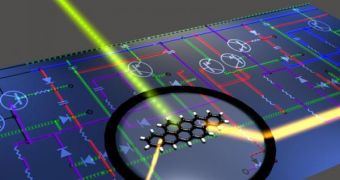Optical computers have been envisioned for quite some time now, but creating one is not as easy as dreaming about it. There are a number of obstacles to be overcome in this endeavor, and one of the largest is the size of the transistors making it up. But this shortcoming may have been resolved, as researchers from ETH Zurich managed to create the first optical transistor that is only made up of a single molecule. The innovation could help considerably further optical computing manufacturing.
In optical computers, the main idea is to generate central processing units (CPU) that work with photons, rather than electrons. This need was brought forth by the fact that conventional, existing CPU tend to generate an enormous amount of heat, of up to 125 watts per square centimeter. Largely responsible for this heat are the millions of transistors that are constantly switched on and off, and amplify the signal running through the processor as a whole. The temperature the units achieve while doing this can be up to ten times higher than that of an electric hotplate.
Photons are a better choice than electrons in powering processors because they do not cause nearly as much heat as regular processors do, and also because they enable much higher transfer rates within the device. However, building a CPU that takes advantage of these traits has proven to be extremely difficult, as evidenced by the fact that the attempts made so far – and there were many of those – were ineffective.
“Comparing the current state of this technology with that of electronics, we are somewhat closer to the vacuum tube amplifiers that were around in the fifties than we are to today’s integrated circuits,” says ETH Zurich Laboratory of Physical Chemistry professor Vahid Sandoghdar, quoted by ScienceDaily. He adds that a compact optical transistor will most likely not be created in the immediate future. The expert also explains that the existing optical transmission technologies operate by making use of photons, but that the mechanisms and switches used to encode the signal in order for this to happen are still controlled electronically.
For their innovative molecule, the team used a single molecule, which they controlled with laser light. When the molecule is in its ground state, a laser beam hitting it is absorbed, but its energy gets stored in the molecule. The scientists understood that it was possible to release the energy by hitting with a second laser beam, which allowed them to control the way the molecule released its charge. The same principle of stimulated light was explained by Einstein some 90 years ago, and a form of it is also used to create the lasers themselves.
“Amplification in a conventional laser is achieved by an enormous number of molecules,” Sandoghdar said. However, he mentioned, the molecule had to be cooled down to minus 272 degrees Celsius (minus 457.6 degrees Fahrenheit), because it became apparent that molecules increase their surface area for interaction with light at temperatures only one degree above absolute zero.

 14 DAY TRIAL //
14 DAY TRIAL //